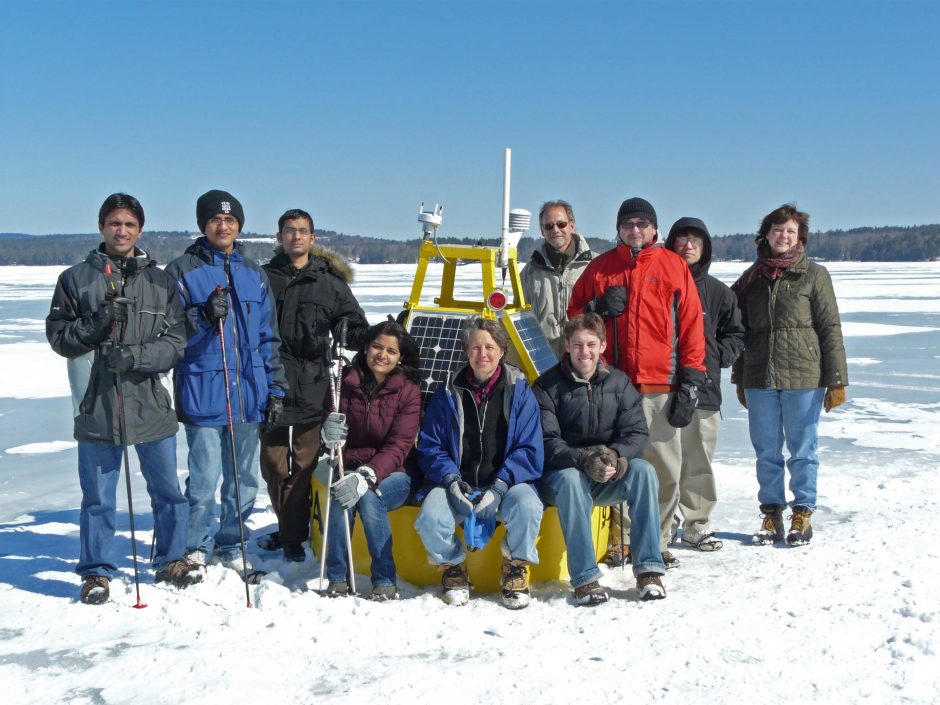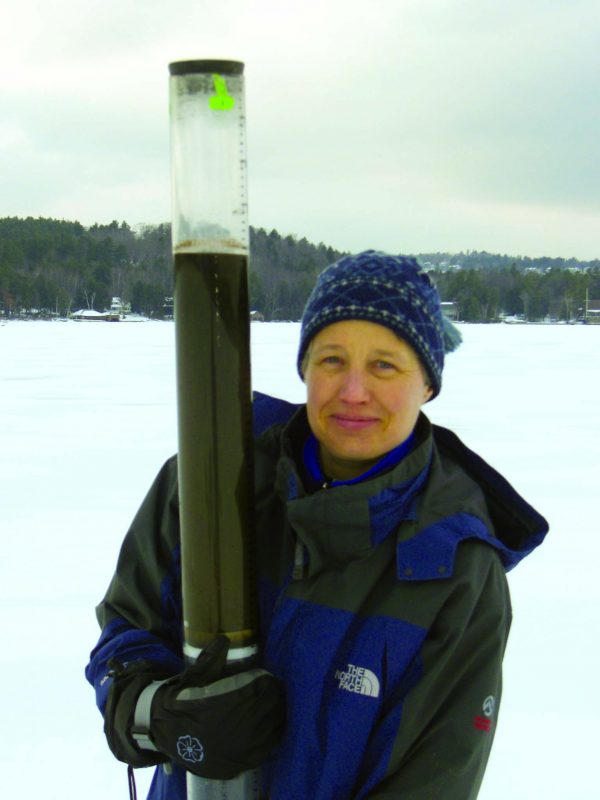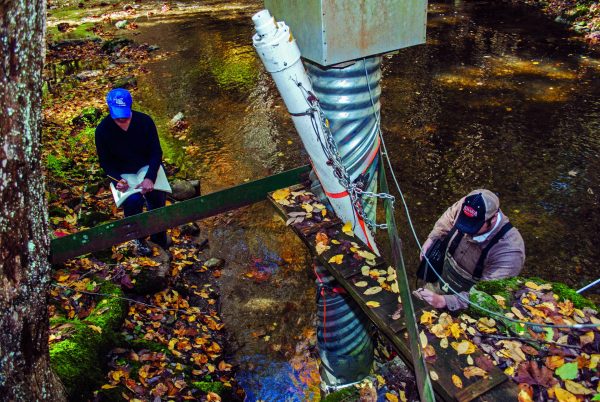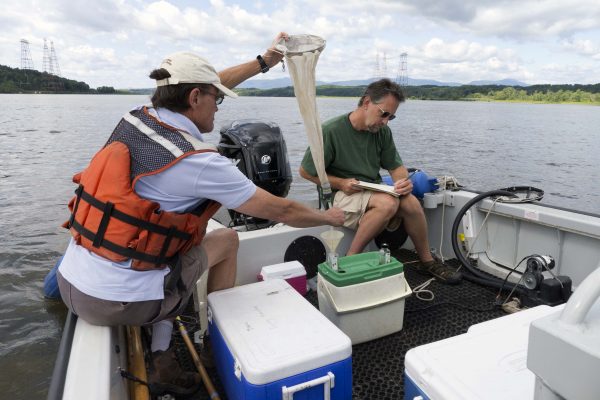From Acid Rain to Cyanobacteria, Cary Institute of Ecosystem Studies is a Leader in Environmental Monitoring

Dr. Kathleen Weathers of Cary Institute (seated in the center) and other members of the Global Lakes Ecological Observatory Network (GLEON) at an observation buoy on a frozen lake. The buoy monitors depth profiles of temperature, specific conductance, dissolved oxygen, and pH as well as weather above the water surface. The people sitting around the buoy are computer, environmental and social scientists (and students) working on the GLEON cyber infrastructure team, supported by an NSF grant. The buoy is the Lake Sunapee protective association’s GLEON buoy. (Credit Holly Ewing, Lake Sunapee, NH)
Cary Institute of Ecosystem Studies, an independent environmental research organization in Millbrook, NY, is a leader in environmental monitoring – particularly long-term monitoring that spans decades.
Steve Hamilton is a freshwater ecologist at Cary Institute and professor at Kellogg Biological Station, a member of the Organization of Biological Field Stations (OBFS), at Michigan State University. Hamilton explains, “Environmental monitoring is how ecologists keep a finger on the planet’s rapidly-shifting pulse. By tracking ecological indicators over long timescales, we can identify patterns and better understand how ecosystems are changing. This understanding will guide us as we work to adapt to and mitigate environmental degradation.”
The discovery of acid rain in North America by Cary Institute founder Gene Likens is a case in point.
“In the 1980s, the pH of precipitation (rain and snow) in the eastern United States was surprisingly acidic – a pH of around 4.3,” says Hamilton. “By monitoring precipitation chemistry in the White Mountains of New Hampshire, and then in Ithaca, NY, Likens was able to link increasing air pollution from sources such as vehicles and power plants with rising precipitation acidity. This finding, a product of environmental monitoring, helped underpin the formation of the Clean Air Act.”
Since the passage of the Clean Air Act, precipitation has become far less acidic and is now closer to pH 5. For reference, water with a pH of 4.3 has five times the acidity of water at pH 5.

Dr. Kathleen Weathers of Cary Institute with a sediment core retrieved from beneath an ice-covered lake. (Credit Midge Eliassen, Lake Sunapee, NH)
Today, Cary’s freshwater monitoring program spans local to international scales – starting with a stream that runs through the Institute’s property, Wappinger Creek, which has been monitored since the 1980s.
Victoria Kelly is the Environmental Monitoring Program Manager at Cary Institute. Kelly says, “A concerning trend that has emerged from the Wappinger Creek dataset is increasing salinity – the result of salt treatments applied to icy winter roads. Salt accumulates in the soil and groundwater and can take decades to flush out. Salt pollution threatens drinking water and ecosystem health.”
To continuously measure salinity in Wappinger Creek, researchers use a conductance probe because the electrical conductivity of water is dominated by road salt. Campbell Scientific sensors are used to continuously measure water level, water temperature and specific conductance for the Wappinger Creek monitoring. By documenting the fluctuating salt concentrations and identifying their ecological effects, Cary scientists help build the case for smart road salt application among regional municipalities.

Victoria Kelly and Mark Leopold measuring discharge at the long-term monitoring station on Wappinger Creek at Cary Institute. Mark Leopold is using a Marsh McBirney flow meter to measure the flow rate of the stream. Equipment pictured – a stilling well with a Handar float and pulley stream height gauge, used to measure stream height. (Credit Heather Malcom, East Branch of Wappinger Creek)
Kelly explains, “Without long-term monitoring of salinity in Wappinger Creek, it would be difficult to connect road salt contamination with other ecological effects. These data show us that salt concentrations are increasing in the environment. This raises a red flag. Without better management, the trend will intensify, putting streams and aquatic life at greater risk. We share this information with managers and recommend best-practice strategies to help achieve safe winter roads as well as healthy streams.”
Cary research follows Wappinger Creek from Millbrook into the Hudson River – a continuous monitoring effort that now exceeds 30 years.
Hamilton is a collaborator on the Hudson River program. He says, “Cary scientists help maintain a network of automated sensors on the Hudson in partnership with the Hudson River Environmental Conditions Observing System (HRECOS). These long-term datasets illuminate overarching trends across the Hudson ecosystem; water quality and invasive species are two top areas of monitoring.”
During the ice-free season over the past 30 years, Cary researchers have sampled the river to measure a range of water quality indicators including nitrogen and phosphorus levels, algal biomass, sediments, conductivity, and populations of phytoplankton and zooplankton. Sondes are used to measure pH, conductance, dissolved oxygen and chlorophyll at various depths. YSI EXO sondes are used for the Hudson River work. A YSI EC300 field meter is also used to measure conductivity.
Cary aquatic ecologist Stuart Findlay leads a network of citizen scientists who monitor submerged aquatic vegetation throughout the freshwater portion of the Hudson River.

Dr. Stuart Findlay and David Fischer collecting a sample of microzooplankton with a plankton net for the NSF-funded Long-term Research in Environmental Biology project. (Credit Heather Malcom, mid-Hudson River)
Findlay explains, “Native water celery beds are especially important as they provide essential habitat for fish and other aquatic organisms. However, invasive species such as water chestnut are robbing water celery and other native plants of resources, making it difficult for them to survive. By maintaining long-term records of aquatic vegetation – including the location and condition of native beds – we can help managers better conserve native plants and target invasive species management efforts.”
From local stream monitoring to sampling the entire length of the Hudson River, Cary freshwater research extends into international waters with programs like the Global Lakes Ecological Network (GLEON). Co-founded by Cary ecosystem ecologist Kathleen Weathers, GLEON is a grassroots network of lake researchers, managers, and citizen scientists studying lakes around the world. Monitoring buoys on these lakes collect information on water quality, weather, and gas exchange between lakes and the atmosphere.
Harmful algal blooms—often composed of cyanobacteria—in lakes are a key research focus. Lakes are turning green as excess nutrients from industrial and agricultural pollution flow into water bodies and fuel cyanobacteria growth. These blooms can become toxic – rendering freshwater undrinkable and unfit for recreation. Early warning of an impending bloom can help managers alert lake users to prevent human contact with toxic water.
Weathers says, “We are developing methods to forecast cyanobacterial outbreaks using satellite imagery and drones, paired with long-term on-the-ground data collected in lakes throughout the northeast. The efficacy of these systems relies on long-term environmental monitoring, which makes it possible to identify patterns and determine conditions indicative of an impending bloom.”




0 comments